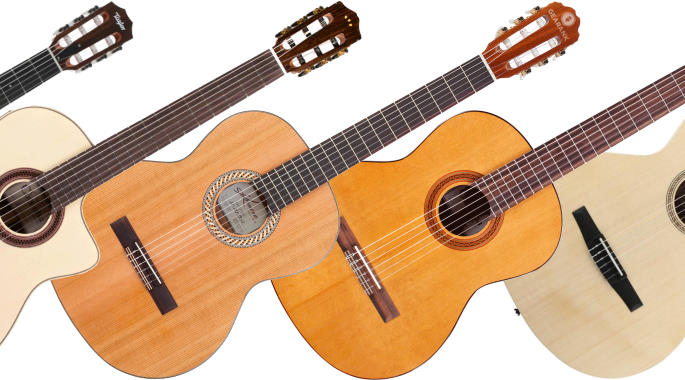
Disclosure
We recommend all products independently of 3rd parties including advertisers. We earn advertising fees from:
• • • • •

• • • • •
Amazon
As an Amazon Associate we earn from qualifying purchases.
• • • • •
Acoustic Guitar Guides
You have plenty of options if you’re looking for the best nylon string guitar. You can choose from conventional classical guitars and flamenco to modern models with specs, shapes, and sizes that go beyond the usual.
Here, we showcase the best nylon string guitars that cover all these types so you can choose the voicing, body shape, and playing feel that suits your musical style.
Classical guitars retain a specific profile and specifications that fit the classical music genre, making them the default guitars for many music conservatory teachers and students.
Flamenco guitars have a slightly different design to handle more aggressive and percussive playing styles.
Other nylon string guitar variants are meant to appeal to those who want nylon strings’ tone and soft feel minus the bulk and traditional look of classical and flamenco guitars.
The nylon string guitar is still an excellent beginner-friendly choice because of how easy the strings are to play. But they are by no means simple instruments. In the hands of professionals, they are shown to be sonically rich and complex.
Whether you are a beginner, looking to study classical or flamenco music seriously, or want to expand into nylon string territory, these market favorites will be a good fit.
The Best Classical & Nylon String Guitars – 2024
| Gearank* | SRC* | Check Price | ||||||
|---|---|---|---|---|---|---|---|---|
| Under $200 | ||||||||
 | Yamaha C40II Classical Guitar | 93 | 2100+ | |||||
| Under $500 | ||||||||
-300x210.jpg) | Kremona Soloist S65C | 95 | 90+ | |||||
| Under $750 | ||||||||
 | Cordoba C7 CD | 95 | 225+ | |||||
 | Taylor Academy 12-N Nylon String Guitar | 92 | 70+ | |||||
| Under $1000 | ||||||||
 | Cordoba GK Studio Negra Flamenco Guitar | 95 | 200+ | |||||
Author & Contributors
Alexander Briones
I have been writing about and researching music gear for many years, all while serving as a music director at my local church. I engage in guitar playing and singer-songwriter stints, in addition to mentoring young musicians and teaching guitar and bass.
The Best Classical Guitar Under $200
Yamaha C40II Classical Guitar
Cons
- Generic specs with laminate wood
- Lacks sustain
Pros
- Time-tested quality and longevity
- Most popular student classical guitar
- Good clarity and balanced sound
- Incredible value for money
The Yamaha C40 has been the best classical guitar for beginners for decades, and rightly so. It gets the most teacher recommendations and continues as the perennial classical guitar for novices.
On paper, it doesn't offer anything out of the ordinary. It just bears the expected characteristics of a classical guitar, including the body shape, nut width, scale length, and string height. But thanks to Yamaha's penchant for build quality and attention to detail, they have made a seemingly ordinary instrument, into a consistent market favorite.
This good build quality translates to good playability, is easy enough for beginners, and can also handle advanced techniques experienced musicians use.
Given its price, there can be inconsistencies with the fretwork and setup, but mine was adequately set up, so I didn't experience the problem personally. I never even had any work done on the guitar work after that.
It also has a balanced sound with good clarity and projection, and it feels responsive to how strong or soft the strings are plucked. My main gripe is its lack of sustain, and volume dips quickly after playing a note.
Longevity is another common reason the C40 is one of the most universally recommended beginner guitars. The Yamaha C40 I used while I was enrolled in classical guitar studies is still playable. Many teachers, myself included, have years' worth of good stories to tell about the instrument.
And to this day, the C40 is still the talk of the town regarding classical guitar deals.
It is easily one of the best classical guitars in popularity and widespread use.
Note that this nylon string guitar is different from what comes to mind for professional playing. But it is one of the great classic guitars for classical and nylon string guitars.
Whether you specifically want to learn Classical Guitar or you want to learn guitar in general, you can't go far wrong with the world's best nylon guitar for students, the Yamaha C40.
--Ed, Jason Horton
Features
- Top: Laminated Spruce
- Body: Meranti back & sides
- Finish: Gloss
- Bridge: Rosewood
- Neck: Nato
- Fingerboard: Rosewood
- Scale Length: 650 mm (25 9/16")
- Nut Width: 52 mm (2 1/16")
| Website | Source | *Rating Value |
| YouTube | 5 Minute Music | 95/100 |
The Best Classical Guitar Under $500
Kremona Soloist S65C Classical Nylon String Guitar
Cons
- Can be a bit too bright for some
- Fret work is hit or miss
Pros
- Solid cedar top
- Handcrafted in Bulgaria
- Lively tone with detailed highs
- Good overall quality for the price
European-made guitars are usually not associated with affordability, but there are exceptions, like the Kremona Soloist S65C. This guitar is handcrafted in Bulgaria but retains a reasonable price tag.
Since production is not outsourced, Kremona has better control over quality, translating to less build quality and material-related issues.
Kremona began life in 1924, founded by Dimitar Georgiev, a gunsmith-turned-luthier after his apprenticeship at Markneukirchen, Germany.
Thanks to its solid cedar top, it has a lively tone with detailed highs. The extra emphasis on the highs gives it a trebly zing rare among nylon string guitars, making it viable for non-classical types of music. It's not overly bright and stays within traditional classical guitar tones.
Response and projection are also outstanding. Shifting the right-hand position dramatically changes the flavor of the voicing, warmer near the neck and brighter near the bridge.
And it also responds well to dynamic changes as you play. This makes it an excellent baseline nylon string guitar to develop preferences for construction tone and feel.
The neck shape can be a hit or miss depending on the player, but it is a non-issue since I am used to traditional classical guitar necks. Those used to narrower steel string guitar necks will notice a substantial difference.
The Soloist S65C is an excellent pick whether you're starting or want a backup guitar for your collection.
Features
- Top: Solid Red Cedar
- Body: Sapele back & sides
- Finish: Natural
- Bridge: Indian rosewood
- Neck: African Mahogany
- Fingerboard: Indian Rosewood
- Scale Length: 650 mm (25.6")
- Nut Width: 52mm (2.04")
| Website | Source | *Rating Value |
| truemeliorist | 90/100 |
The Best Nylon String Guitars Under $750
Cordoba C7 CD
Cons
- Not for purists who prefer traditional specs
- Average quality tuners
Pros
- Responds well to playing nuances
- Comfortable playability, easy on the hands
- Good example of fine craftsmanship, beautiful in detail and design
- Excellent sustain and projection
With its impressive build quality and value, Cordoba continues to make waves in the nylon string guitar market. They offer masterfully built guitars for the price, with the Cordoba C7 being one of their prime offerings.
The C7's construction features a solid Canadian cedar top and Indian rosewood back and sides. This allows it to produce a resonant and rich sound with good midrange clarity, which I particularly like. The traditional
Spanish fan bracing enhances projection, ensuring that each note is projected in detail.
Cordoba's attention to detail is evident in the hand-inlaid rosette. I am genuinely impressed by the brand's commitment to artisanal excellence.
Fitted with premium Savarez strings, this guitar consistently delivers a reliable and expressive sonic experience.
Playability is up to par with traditional classical guitars, but the C7 is more comfortable with its slightly thinner body and neck. But this is something that purists won't be too happy about. Thankfully, the difference is very subtle.
The hardware could be better, but they get the job done. Given its price, expecting it to have premium hardware would be unfair.
Speaking of price, it requires an investment, but the quality and longevity you're getting are well worth it.
The Cordoba C7 is a commendable choice for beginner to intermediate guitarists on a quest for classical brilliance.
Specifications
- Top: Solid Western Red Cedar
- Body: Rosewood
- Finish: Gloss Polyurethane
- Bridge: Rosewood
- Neck: Mahogany
- Finger Board: Rosewood
- Scale Length: 25.5"
- Nut Width: 2.0"
Taylor Academy 12-N Nylon String Guitar
Cons
- Not a traditional classical guitar
- A bit expensive for a student guitar
Pros
- Crossover design - steel string neck feel
- Solid spruce top
- Premium build quality
- Warm yet detailed tone
Taylor Guitars is well known for its premium steel string acoustics, but it occasionally treads unfamiliar territory. A case in point is the Academy 12-N, a nylon string guitar with a modern design and playability.
It has to be mentioned that this is not a traditional classical guitar. Instead, it follows Taylor's Academy series specs, having a grand concert body and a narrower neck, which makes it look and feel more similar to its steel-string siblings.
The neck doesn't follow traditional specs, with its narrower 1.875" nut width and 25.5" scale length. This makes the Taylor Academy 12-N more of a crossover instrument, ideal for steel string players who want to try playing nylon strings. So, this is not for you if you are looking for a true-to-form classical guitar.
Thanks to its solid top and the big lower bout of its grand concert body, the Academy 12-N has a warm tone with slight bumps in the mids and lows. This is quite a departure from the usual trebly tone expected from Taylor acoustics.
The bass is deep yet retains clarity and doesn't overwhelm the highs. It has good projection but a hard time sustaining notes.

Beveled Armrest
Taylor is a brand that's hard to fault when it comes to build quality, and this same standard applies to the Academy 12-N. This attention to detail makes the Taylor Academy the best-value nylon string guitar for those who do not want to compromise quality.
Another noteworthy feature of this guitar is its beveled armrest, which makes right arm positioning comfortable. It also comes with a modern TUSQ nut and saddle. There's also an acoustic-electric version available, the Taylor Academy 12e-N.
While its quality does punch above its price range, this student guitar from Taylor is priced higher than other entry-level nylon string acoustic guitars. But its well worth the price given that it's from one of the best acoustic guitar brands.
Still, this is for you if you're willing to invest in a premium and easy-to-play crossover nylon string guitar.
Features
- Top: Solid Lutz Spruce
- Body: Layered Sapele back & sides
- Finish: Varnish
- Bridge: Ebony
- Neck: Mahogany
- Fingerboard: Ebony
- Scale Length: 25.5"
- Nut Width: 1.875"
| Website | Source | *Rating Value |
| YouTube | Heartbreaker Guitars | 98/100 |
The Best Nylon String Guitar Under $1000
Cordoba GK Studio Negra Flamenco Guitar
Cons
- Lacks projection due to thinner body
- Can be too sensitive to attack
Pros
- Balanced voice with clear highs and lows
- Consistent and reliable, superb build quality
- Good sustain with harmonic overtones
- Gritty and percussive flamenco tone when hit hard
The Cordoba GK Studio Negra is a flamenco-style nylon string guitar with a soft cutaway and built-in Fishman Presys Blend electronics.
It is an acoustic-electric guitar for flamenco, with a thinner nut, reduced scale length, and lower action, all of which make the instrument great for flamenco playing techniques.
Since it can handle flamenco's blazing fast runs and percussive attack, it'll easily tackle anything else that you can throw at it, and you can do so with less stress on your hands. This easy playability is its focal point.
It sports premium specs that include a solid European spruce top supported by Spanish-style fan bracing, and what separates it from the standard studio version is the use of rosewood for the back and sides. And build quality is up to par, if not above its pay grade.
It has a balanced voice with good upper and low-end clarity. The string balance is superb and sustains notes well, complete with complex harmonic overtones.
The downside to its thinner profile is its lack of projection. Lower action means the notes have more grit when plucked hard, sometimes even buzzing.
Losing clarity when you hit the strings hard is more of a design choice, given that this guitar is meant to emphasize flamenco-style percussive attack.
While this guitar is meant for flamenco, it can handle other styles, including jazz, blues, folk, pop, and even classical - as long as you don't overdo your right-hand attack.
The Cordoba GK Studio Negra is the best nylon string guitar for fans of flamenco, and with its built-in pickups, it's viable for stage use with other styles of music.
Specifications
- Top: Solid European Spruce
- Body: Rosewood back & sides
- Finish: High gloss PU
- Bridge: Indian Rosewood
- Neck: Mahogany
- Fingerboard: Rosewood
- Scale Length: 650mm (25.6")
- Nut Width: 50mm (1.96")
- Electronics: Fishman Presys Blend with 4 Band EQ + phase, undersaddle piezo and internal microphone with blender, built in digital tuner
| Website | Source | *Rating Value |
| Gitarzysta | Editor | 90/100 |
Things to Consider When Buying a Nylon String Guitar
This section explains some of the terminologies you will come across when you look at nylon string guitars and discuss them - this, along with a few tips, will help you determine which guitar characteristics will suit your playing style.
If you need clarification on the different parts of a guitar, then the diagram at the bottom of this blog post will explain them to you.
Flamenco Guitars are generally built to have a more punchy sound and are intended to be played in a more percussive style, including tapping on the top soundboard - in fact, they usually have a protective plastic cover called a golpeador to facilitate this without damaging the finish. They have a smaller nut width, which means the strings are closer together than on a standard classical guitar, and a lower action (aka string height). They are often made with spruce tops and cypress or sycamore back and sides to enhance volume from their thinner bodies. Their tonal characteristics are designed to cut through the sound of dancers loudly clapping and tapping their feet.
Classical Guitars usually have deeper bodies, wider nut widths, and higher action than flamenco-style guitars. They typically have thicker spruce or cedar tops and rosewood or mahogany backs and sides, which tend to give them a more mellow or rounded tone roughly covering the frequency spectrum of an orchestra. They are primarily intended to be played solo or in tiny ensembles.
Spanish Guitars are a sub-set of classical guitars traditionally made in Spain with bracing, construction techniques, and tonal characteristics, which experts say vary by region.
Concert Guitars are high-end classical guitars made by luthiers, usually following centuries-old traditional methods and the use of expensive materials. A typical luthier may only produce 4 to 6 guitars per year or, in a more extensive operation, perhaps as many as 20. A lower-priced concert guitar usually costs between $2,000 and $3,000, with higher-end models going well into the 5-figure range.
Nylon String Guitars include all of the types of guitars above in addition to many modern hybrid guitars which can combine characteristics of many different kinds of guitars, including steel-string acoustic and electric guitars as well as some that come with pickups and electronics built-in. Due to this guide's price range, most guitars here are considered Classical, Flamenco, or Hybrid guitars.
- Instead of being a distinct type like the ones listed above, this refers to nylon string guitars designed with specifications that make it easy to transition from steel-string guitars, and as such, many of the types above can be made with crossover characteristics. The main one is that they typically have smaller nut widths, so the strings are closer together than on a standard classical guitar. Traditional classical guitars also have flatter fingerboards (a larger fingerboard radius) than regular acoustics while crossover guitars can have curved fingerboards. Some crossover models also feature a cutaway to make it easier to reach the higher frets - particularly with acoustic-electric models. These pickup-equipped models can plug into an amp or a PA Mixing Console.
- Like other guitars, there are ongoing discussions and debates about which wood species produce superior tones or tones better suited to certain playing styles. Two main types of wood are used for the top or soundboard of nylon string guitars:Spruce is generally considered to produce a crisper tone with more definition, while Cedar is regarded as having warmer or darker tones.
However, many luthiers will tell you that the thickness of the wood, types of bracing, and other construction techniques can be just as important as the materials in determining the tone.
Everyone agrees that having a solid wood top instead of a cheaper laminated wood top will provide better projection (they'll be louder) and lead to richer tones over time as the wood grains open up. The caveat is that on cheap guitars under about $200, a laminated top will have a more consistent tone between individual guitars of the same model than the variations in grain that come with cheap solid woods.
Similar discussions occur about the woods used on the rest of the guitar, but the top or soundboard dominates in tone.
Solid mahogany for the back and sides is a popular configuration, but they are priced much higher than the scope of this guide.
- This is essentially the distance measured between the saddle and the nut, or more accurately described as double the distance from the nut to the 12th fret plus some "compensation" added by the saddle's position. A longer scale length requires higher tension in the strings, resulting in a brighter tone. Stewart MacDonald presents a more detailed explanation with examples quite well, and a good description of the implications of different scale lengths can be found on Guitar Player.
- This is the main thing determining the distance between the strings, although the width at the saddle plays a minor role, too, with the strings usually being closer to each other at the nut than at the saddle. The nut width and action height are the things that most influence the 'playability' of a guitar, with smaller nut widths better suited to guitarists transitioning from steel-string guitars.
- Instruments with a low Guitar Action allow faster runs and easier use of advanced playing techniques. But this comes at the expense of introducing some fret buzz, a feature of flamenco-style playing. Beginners and those transitioning from steel-string acoustic or Electric Guitars generally find a lower action easier to play. For a more in-depth discussion on this topic see this Delcamp Classical Guitar Forum thread.
- Acoustic-Electric models come with pickups and other electronics such as preamps and EQ installed, while the straightforward acoustic models don't. These additional components may have subtle effects on the tone or resonance of the guitar, but the most practical differences are that they cost more but can be amplified.
- The short answer is no. A nylon-strung guitar is not built to handle the tension of steel strings. It can be done with some modifications, but you won't get the most out of your steel string, so it's not worth it. On the other hand, steel-string acoustic guitars can handle nylon strings easily, but adjustments on the nut and saddle will make it work. The identical downside applies: you won't get the natural feel and sound of nylon strings when used this way. So for best results learn how to string a classical guitar with the proper strings.
The Different Types of Classical Guitars
Crossover Nylon String Guitars
Tonewoods
Scale Length
Nut Width
Action / String Height
Straight Acoustic or Acoustic-Electric?
Can Steel Strings be Used on a Classical Guitar?
Best Nylon String Guitar Selection Methodology
The first edition was published in 2016.
To be considered for inclusion in this guide a guitar had to meet the following criteria:
- Must have nylon strings
- Priced from $99 to $999.99
- Only 6 string guitars were included
- Must be available from major online retailers in the USA
- Must have upper and lower bouts consistent with a full-sized body
- Types of guitars with nylon strings that were excluded: Travel & Silent Guitars
With these criteria in hand, we looked at the individual guitars that the major retailers in the USA listed as their most popular models and selected the most promising 66 guitars to process for their Gearank rating scores. The Gearank Algorithm processed more than 9,900 reviews and ratings during this process, including the most recent ones, to produce the rating scores out of 100 that you see above.
Finally, we selected the highest rated options to recommend in each price range above.
For more information about our methods, please read How Gearank Works.
Given the availability and price range that this guide covers, you won't see boutique classical guitar brands featured here.
About the Author and Contributors
Here are the key people and sources involved in this guide's production - click on linked names for information about their music industry backgrounds.
Lead Author & Researcher
Alexander Briones
I have been writing about and researching music gear for many years, all while serving as a music director at my local church. I engage in guitar playing and singer-songwriter stints, in addition to mentoring young musicians and teaching guitar and bass.
As a classically trained guitarist, nylon string guitars have a special place in my heart. I have taught many young students on nylon string guitars, and I usually recommend starting this way unless the student specifically wants to learn electric or steel string guitar.
Contributors
Alden Acosta & Jerry Borillo: Product research.
Jason Horton: Supplemental writing, Editing and Illustrating.
Media
Main/Top Image: Produced by Gearank.com using photographs of the Taylor Academy 12-N, Cordoba GK Studio Negra, Kremona Verea Cutaway and Kremona Soloist S65C.
The videos have been embedded in accordance with YouTube's Terms of Service.
The individual product images were sourced from websites, promotional materials or supporting documentation provided by their respective manufacturers.


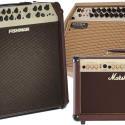
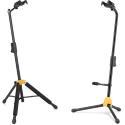
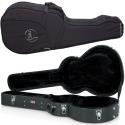
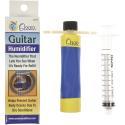
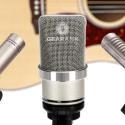
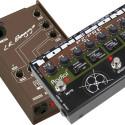

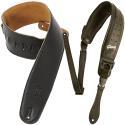

Publication of our September 2022 Edition resulted in the following models coming off the recommended list above:
The following guitars came off the recommended list for this Edition, but you can still see our analysis of them:
We have removed the Yamaha CG102 from the Under $200 recommended list above due to a price increase putting it above $200.
Publication of our June 2021 Edition resulted in the following guitars coming off the recommended list above, but you can still see our analysis of them:
The following guitars came off our recommended list above as a result of our August 2020 update, however you can still see our analysis of them:
We have removed the Cordoba C3M from the list of recommended nylon string guitar under $200 due to its price going up above that level.
As a result of the June 2019 update for this guide the following guitars came off the recommended list above, but you can still read our analysis of them:
The Cordoba Fusion 12 with spruce top and rosewood back/sides at $500 barely used was a DEAL from a pal in another state. I am delighted with it for a modest price and it helps a primary steel / electric player stay with some intermediate classical pieces (Sor etudes, Guardame las Vacas, Alman by R. Johnson, etc.). And I owned 1 and played several built by pro luthier Thos. Rodriguez. For normal play a good mid-range Cordoba is hard to beat and easy to re-sell.
I’m on my second Córdoba c5 and the first one the bridge came off and now this second one is beginning to do the same. You mentioned that was the only negative but unverifiable however I can’t imagine this not happening frequently. Not a well built guitar.
Taylor Academy though
Thanks for mentioning it – the Taylor Academy 12e-N is on our short-list and will be considered for recommendation when we next update this guide.
As a result of the December 2017 update of this guide, several guitars were removed from our recommended list above, but you can still read about them here:
This is an exceptionally well-written and informative article about nylon string guitars and I enjoyed learning about the nuances and main differences among the several varieties. As a writer myself, I feel compelled to point to one tiny, nit-picking correction you could make in order to make it a near-perfect piece.
Near the beginning, under Methodology, you say, “With this criteria in hand . . . ” It should be “these criteria.” Although in your case, because of the high quality of your writing, I would assume it to be a typo, many people are not aware that “criteria” is the plural form of the singular, “criterion.”
Thank you for pointing out the error – I’ve corrected it now. If you look at our other guides you’ll see we do usually refer to ‘criterion’ in the singular and ‘criteria’ in the plural. BTW – We really do appreciate it when our readers help us to improve these guides!
Santos Martinez SM150CEA. My go-to practice guitar. £147 UK price. A real gem in my opinion.
That looks like an interesting guitar, but I couldn’t find anyone selling it at that price – here’s the Amazon UK price.